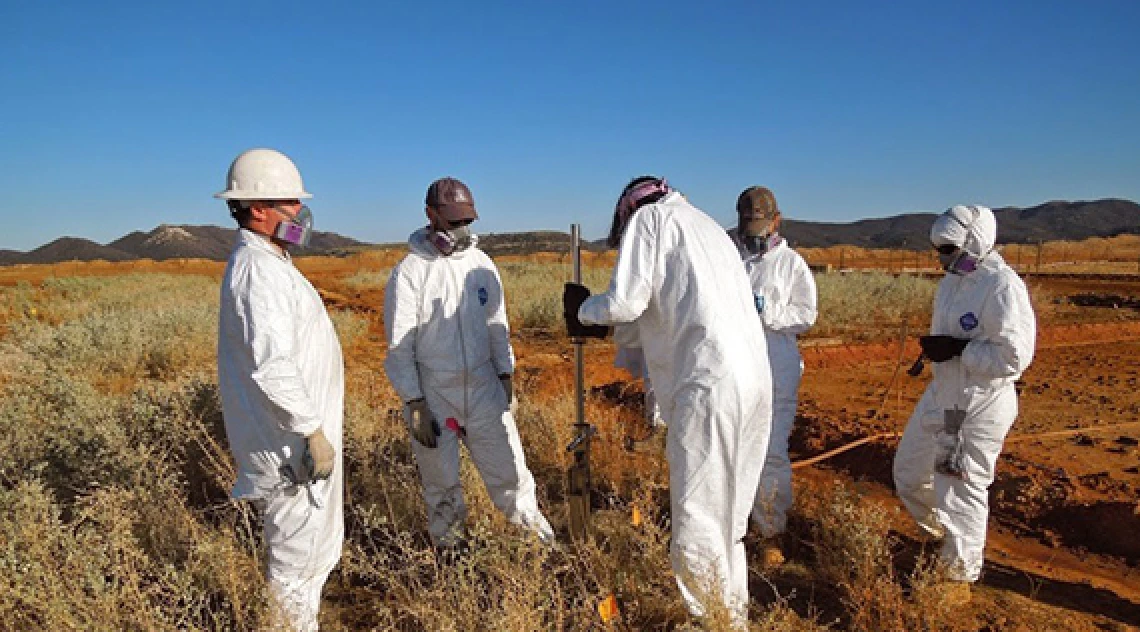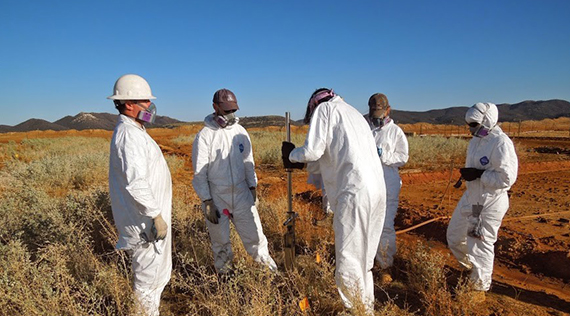Phytostabilization detoxifies arsenic-rich mine tailings

 Corin Hammond, former UA SRP trainee and Wetterhahn Award recipient, recently published her dissertation research on arsenic sequestration by Prosopis juliflora (mesquite trees) during phytostabilization of metalliferous mine tailings in Environmental Science and Technology. This work was also featured by the U.S. Department of Energy in an article entitled: “Plant Roots Police Toxic Pollutants”. Hammond is part of a UA SRP team, led by Dr. Jon Chorover, examining the impacts of phytostabilization on the speciation and fate of arsenic in the plant root zone at the molecular scale.
Corin Hammond, former UA SRP trainee and Wetterhahn Award recipient, recently published her dissertation research on arsenic sequestration by Prosopis juliflora (mesquite trees) during phytostabilization of metalliferous mine tailings in Environmental Science and Technology. This work was also featured by the U.S. Department of Energy in an article entitled: “Plant Roots Police Toxic Pollutants”. Hammond is part of a UA SRP team, led by Dr. Jon Chorover, examining the impacts of phytostabilization on the speciation and fate of arsenic in the plant root zone at the molecular scale.
Mesquite is one of the plants that was tested in phytostabilization field trials at the Iron King Mine and Humboldt Smelter Superfund Site (IKMHSS). Phytostabilization is a bioremediation technology that seeks to immobilize metals in the root zone of metal-contaminated soils. The IKMHSS mine tailings are highly acidic and contain high levels of arsenic as well as other toxic metals. Roots were harvested from three-year-old plants from the field trial and were investigated by microscale and bulk synchrotron X-ray absorption spectroscopy (XAS) and multiple energy micro-X-ray fluorescence imaging to determine iron, arsenic, and sulfur speciation, abundance, and spatial distribution.
Harvested roots were sliced into 30 microns thin sections and analyzed using micro x-ray florescence imaging. “This research was conducted first at the Stanford Synchrotron Radiation Lightsource (SSRL) and then at the Brookhaven National Synchrotron Light Source II (NSLS-II) on highly sought after beam lines using top-of-the-line detectors and customized instrumental setups,” Hammond said. “Beam time is precious, so work continues around the clock after the beam line scientists go home.” Hammond said the chance to work with the synchrotron was an honor that came with little sleep.
Team member Dr. Rob Root explains: “The SSRL results showed evidence for arsenic sequestered in small pockets or vacuoles inside the roots. The higher resolution from NSLS-II instrument confirmed the SSRL results showing the same pockets, which was encouraging,” Dr. Root said. “We speculate that the plant is using those vacuoles as a mechanism to avoid toxic response. It didn’t translocate to the above ground biomass, so it is actually keeping it in the subsurface.”
Prosopis juliflora (mesquite trees) plant roots were shown to use a combination of two mechanisms to scavenge and immobilize arsenic from mine tailings. The first was binding of As(V) to ferric sulfate plaques on root surfaces and the second was sequestration of As(III) complexes in root vacuoles.
A big UA SRP congratulations to the research team! This publication was selected by the National Synchrotron Light Source II (NSLS-II) and presented to the Department of Energy (DOE) as an example of the best science performed recently at NSLS-II.
Publication:
Hammond CM, Root RA, Maier RM, Chorover J. 2018. Mechanisms of Arsenic Sequestration by Prosopis juliflora during the Phytostabilization of Metalliferous Mine Tailings. Environ Sci Technol. 2018 Feb 6; 52(3): 1156–1164. PMC5930015.

